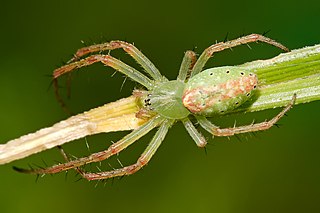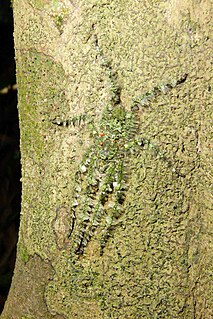
Orb-weaver spiders are members of the spider family Araneidae. They are the most common group of builders of spiral wheel-shaped webs often found in gardens, fields, and forests. The English word orb can mean "circular", hence the English name of the group. Araneids have eight similar eyes, hairy or spiny legs, and no stridulating organs.

Myrmarachne is a genus of ant-mimicking jumping spiders that was first described by W. S. MacLeay in 1839. They are commonly called antmimicking spiders, but they are not the only spiders that have this attribute. The name is a combination of Ancient Greek μύρμηξ, meaning "ant", and ἀράχνη, meaning "spider".

Philoponella is a genus of uloborid spiders. Like all Uloboridae, these species have no venom.

Burmattus is a genus of Asian jumping spiders that was first described by Jerzy Prószyński in 1992. The name is derived from "Burma", and "-attus", a common suffix for salticid genera.
Ceglusa is a monotypic genus of Burmese jumping spiders containing the single species, Ceglusa polita. It was first described by Tamerlan Thorell in 1895, and is only found in Myanmar. It was described from a single 5 millimetres (0.20 in) long female, and no drawings exist. and no studies were published on it since. Its taxonomic relationships within the family are unknown.
Charippus is a genus of spiders in the jumping spider family, Salticidae.

Piranthus is a genus of jumping spiders first described in 1895 by Tamerlan Thorell, who derived the name from Greek mythology. As of February 2019 this genus contains only two species.

Rhene is a spider genus of the family Salticidae.
Zeuxippus is a genus of Asian jumping spiders that was first described by Tamerlan Thorell in 1891. They look similar to members of Rhene, but their abdomen is longer, more obtuse, and thinner. In addition, the first pair of legs is thicker than the others.

Stenochilidae is a family of southeast Asian araneomorph spiders that produce ecribellate silk. First described by Tamerlan Thorell in 1873, it now contains twelve described species in two genera.

Uloborus is a spider genus in the family Uloboridae with 72 described species. Most species occur in the tropics and subtropics, with only few species in northern America and Europe.

Cyrtophora, the tent-web spiders, is a genus of orb-weaver spiders first described by Eugène Simon in 1895. Although they are in the "orb weaver" family, they do not build orb webs. Their tent-like, highly complex non-sticky web is sometimes considered a precursor of the simplified orb web. These webs are aligned horizontally, with a network of supporting threads above them. These spiders often live in colonies. Females have a body length of mostly about 10 millimetres (0.39 in) long. Some members, including Cyrtophora cicatrosa, exhibit the ability to change colour rapidly.

Thwaitesia is a genus of comb-footed spiders that was first described by Octavius Pickard-Cambridge in 1881.

Dolichognatha is a genus of tropical and subtropical long-jawed orb-weavers that was first described by Octavius Pickard-Cambridge in 1869. Originally placed with the Archaeidae, it was transferred to the Araneidae in 1967, and to the Tetragnathidae in 1981.

Cyrtarachne is a genus of orb-weaver spiders first described by Tamerlan Thorell in 1868.

Pandercetes is a genus of huntsman spiders that was first described by Ludwig Carl Christian Koch in his 1875 treatise on Australian spiders. They are mainly distributed in tropical Asia and Australia, and are known for their cryptic coloration that matches local moss and lichen. Their legs have lateral hairs, giving them a feathery appearance, further masking their outline against tree trunks. Their head is somewhat elevated and the carapace has the thoracic region low and flat.

Chilobrachys is a genus of Asian tarantulas that was first described by Ferdinand Anton Franz Karsch in 1892. They are found in India, Myanmar, Malaysia, China, Vietnam, Thailand and Sri Lanka. They are usually medium or large-sized, and they can stridulate by using small spines present on the chelicerae.

Poltys is a genus of orb-weaver spiders first described by C. L. Koch in 1843. Many species are cryptic and are known to masquerade as leaves and twigs during the day, and build an orb web at night to capture prey. The shape of the abdomen which often gives the impression of a rough and broken branch can vary among individuals within a species. The web is eaten up before dawn and reconstructed after dusk.
Janula is a genus of comb-footed spiders that was first described by Embrik Strand in 1932. It is a senior synonym of Monetoculus.
Polyboea is a genus of Asian nursery web spiders that was first described by Tamerlan Thorell in 1895. As of June 2019 it contains only two species, found only in Asia: P. vulpina and P. zonaformis.














